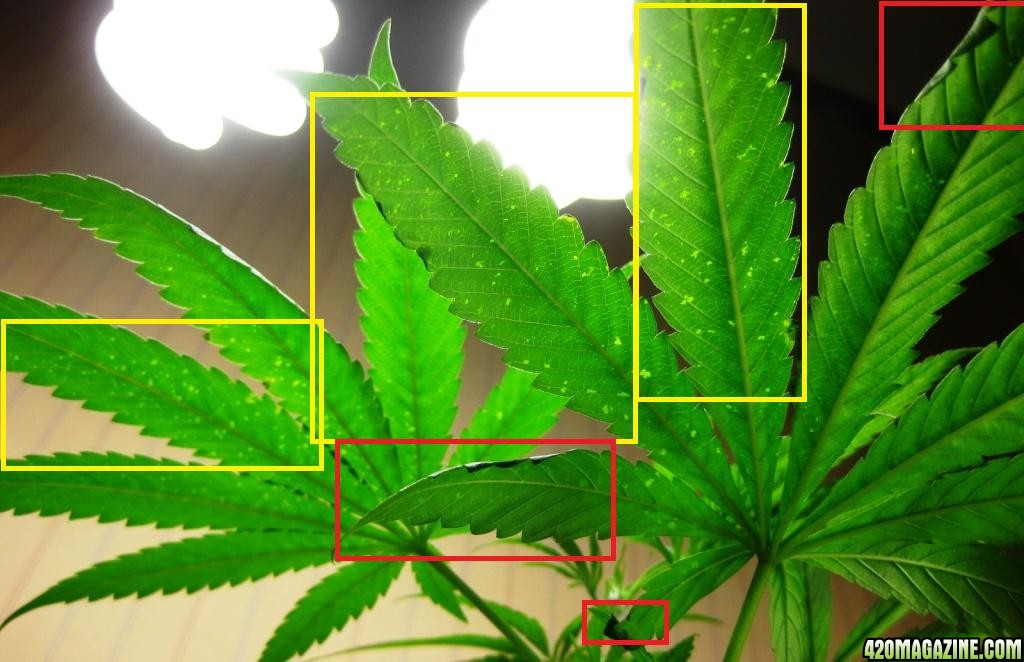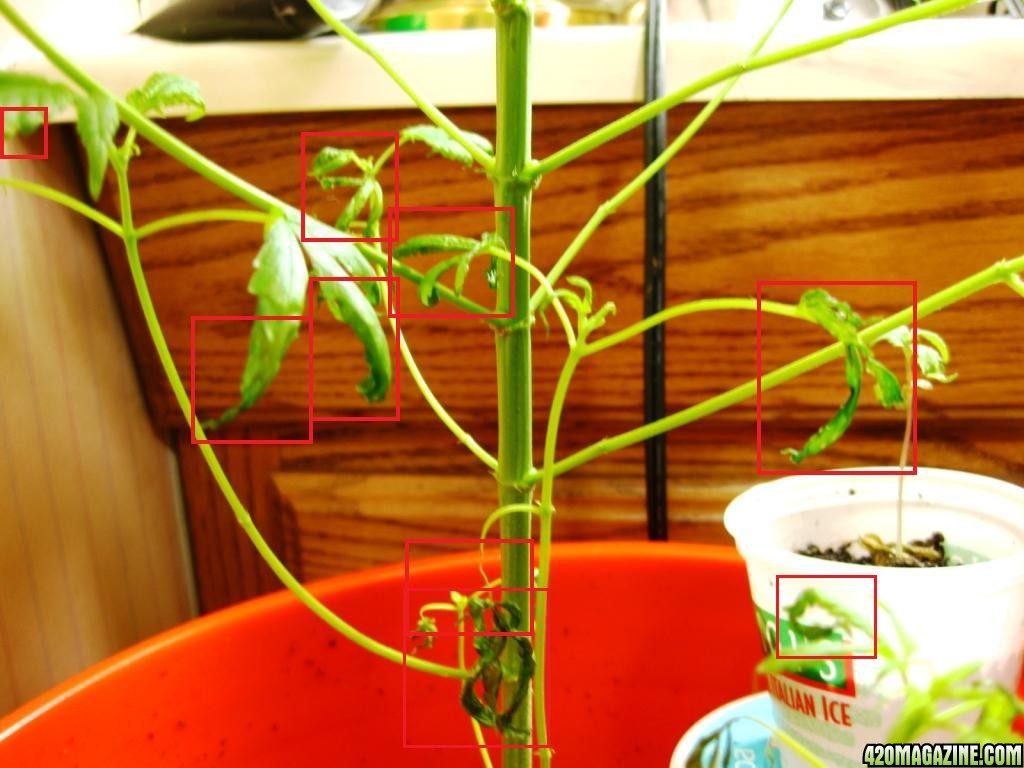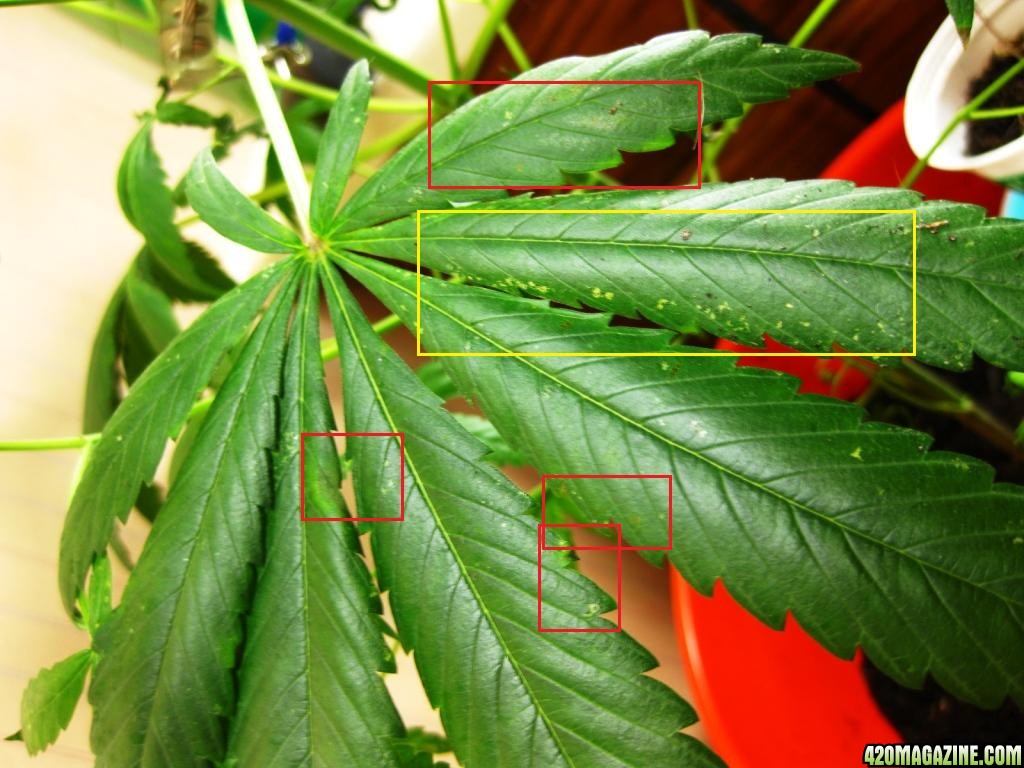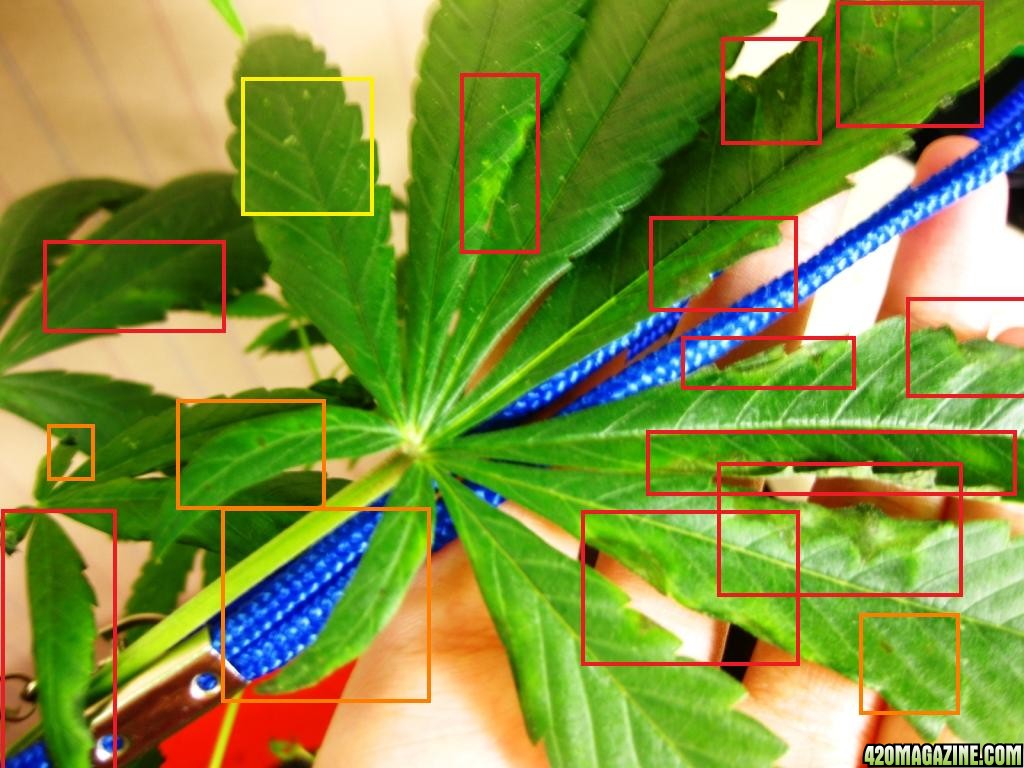Navigation
Install the app
How to install the app on iOS
How To Use Progressive Web App aka PWA On 420 Magazine Forum
Note: This feature may not be available in some browsers.
More options
You are using an out of date browser. It may not display this or other websites correctly.
You should upgrade or use an alternative browser.
You should upgrade or use an alternative browser.
Please help! Urgent! 1st time grower! Hybrid problems and Purple Kush!
- Thread starter LushezAmber89
- Start date
- Thread starter
- #22
LushezAmber89
New Member
i'm not quite sure but that actually looks kinda like a spider mite? regardless, i used the link i posted above. i just followed the directions which say:
it takes a few sprays but it worked! i only tried it on the soil but we just sprayed the leaves and everything about 30 mins ago so I'll let you know for sure how it works in a few days...
i definitely suggest using a neem oil solution and the soap thing... perhaps some fly strips! i'll be getting those soon and i'll let you know how well they work.
Soap/Oil spray for insect pests:
Probably the best overall insecticide recipe is made from dishwashing liquid and cooking oil. It should be applied more frequently than chemical pesticides, but then again, you don't really want to use poison inside your home. Here is the recipe:
1/2 teaspoon dishwashing liquid
1/4 teaspoon cooking oil
1 quart warm water
Mix all ingredients in a small spray bottle. Mist upper and under sides of leaves every 10 days to control mealy bug, spider mite, aphids, thrips, or any other sucking or chewing insects.
it takes a few sprays but it worked! i only tried it on the soil but we just sprayed the leaves and everything about 30 mins ago so I'll let you know for sure how it works in a few days...
i definitely suggest using a neem oil solution and the soap thing... perhaps some fly strips! i'll be getting those soon and i'll let you know how well they work.
Chek
New Member
I'd be willing to bet bottom dollar you are having some stomata problems as well. Stomata are literally like the nostrils of your plant and neem oil along with some of the other issues your having probably clogged them. First thing you should do is go buy some perfect water from a grocery store or run some RO water whichever is more practical. Balance it so around 6 PH and flush 2 gallons of the clear water through your soil per 1 gallon of soil. To reiterate ms fox, those soils are bad bad bad news. I think you can still salvage your grow this way though. Completely flush the soil and use clear water for at least a week thereafter and see if it helps, the wilting is probably a combination of the two (clogged stomata and nute burn) looks like heat may be an issue as well, but its hard to say without actually getting hands on dirt. wash your plants by hand with pure water on the underside but be delicate. if the insects are still an issue, or maybe in lue of all the other advice it may be best to simply transplant these guys ditch all the old soil and sanitize your whole house in a 5% bleach solution... hope things turn around for you and your ladies
Chek
New Member
and that is NOT a gnat... its a spidermite... I keep ladybugs and spiders ... let nature take its course on those guys and avoid the bad karma of killing them. Let the other bugs do that LOL
Chek
New Member
Oh and amber... Too much light is almost impossible, the heat from too many lights maybe, but the more lumens the better
- Thread starter
- #27
LushezAmber89
New Member
Thanks Chek!
I've never heard of perfect water. Once I buy it, how would I control the pH of it if it's not at 6? Do you think distilled water would work?
^^Thanks! I will definitely be doing that and update on the health! It's still not healthy enough for pictures but it's doing a lot better. The insects have declined but I'm still looking for the fly strips to add around my plant.
I am going to go turn on the lights right now and adjust the fan. I believe it may be a heat problem like you said so hopefully the fan will do it's trick.
Would you suggest an oscillating fan over a regular fan?
Thanks for the advice!!!
First thing you should do is go buy some perfect water from a grocery store or run some RO water whichever is more practical. Balance it so around 6 PH and flush 2 gallons of the clear water through your soil per 1 gallon of soil.
I've never heard of perfect water. Once I buy it, how would I control the pH of it if it's not at 6? Do you think distilled water would work?
wash your plants by hand with pure water on the underside but be delicate.
^^Thanks! I will definitely be doing that and update on the health! It's still not healthy enough for pictures but it's doing a lot better. The insects have declined but I'm still looking for the fly strips to add around my plant.
Too much light is almost impossible, the heat from too many lights maybe, but the more lumens the better
I am going to go turn on the lights right now and adjust the fan. I believe it may be a heat problem like you said so hopefully the fan will do it's trick.
Would you suggest an oscillating fan over a regular fan?
Thanks for the advice!!!
- Thread starter
- #28
LushezAmber89
New Member
i2damaxx,
How's your plant doing?
How's your plant doing?
i2damaxx,
How's your plant doing?
BAD!! 3 of them have bend from the stem and i have them on miniture home made crutches:-( I had the fan to close last night... Any Suggestions?? LOOK!
- Thread starter
- #30
LushezAmber89
New Member
Max,
I'm not sure but i say lay off the fan for a bit.
i found this so maybe it will help:
you can read more here Gardening Techniques
I'm not sure but i say lay off the fan for a bit.
i found this so maybe it will help:
Under natural conditions, stems undergo stress from wind, rain, and animals. These stresses, which indoor plants do not ordinarily face, strengthen the stem. Indoor stems grow sturdy enough to support their own weight and not much more. Plant energy is used to produce more light-gathering leaf tissue, rather than wind-resistant stem tissue. Stems remain slender, usually about one-half to three-quarter inches at maturity. Since you are growing the plants for their leaves and flowers, this does not present a problem.
Healthy plants do not ordinarily need support. If many of your plants have weak or spindly stems, there is a deficiency in either light or nutrients (notably potassium). Simply not having enough light will cause the plants to elongate, with sparse foliage and weak growth. Too much red light will cause elongation, too, so make sure you include a strong blue light, if you are using incandescents or floodlights.
Hanging the lights higher than the recommended distances will cause the plants to elongate by rapidly growing up to the lights. Unlike sunlight, the intensity of artificial light diminishes dramatically with the distance from the lights. The plants respond by growing toward the light, seeking the higher intensity.
Under artificial light, some plants may need support during the seedling stage or because of accident. Depending on plant size, use straws, pencils, dowels, or standard plant stakes such as cane sticks. Set them in the soil and affix the stem with string, masking tape, or wire twists such as those that come with plastic trash bags. Do not tie string or wire tightly around the stem; make a loose loop. The stem will grow in girth and can be injured by a tight loop.
Probably the simplest method of support is to take a rigid piece of wire, form a "C" at one end and bend it to a right angle to the stem. Set the straight end in the soil and place the stem inside the "C." Pipe cleaners are ideal for seedlings. With larger plants, straighten a coat hanger and use the same method.
A common practice in greenhouses where tree seedlings are raised is to shake each plant once or twice daily. This practice simulates natural vibrations from the wind, and the plant reacts by increasing the growth around the stem. The stem grows thicker and stronger, and the tree can better fend once it is transplanted. It works the same way with marijuana. A fan blowing on the plants will also work. These practices are useful if you plan to move your plants outdoors. Otherwise, healthy indoor plants that will remain indoors need no special stem strengthening.
you can read more here Gardening Techniques
- Thread starter
- #31
LushezAmber89
New Member
and btw they do look like you can still save them. other than the stem they look pretty healthy!
Chek
New Member
perfect water is just really clean almost totally pure water. like 10 PPM or so. my local grocery store has a water dispensary where you can get water for like 33 cents a gallon, its carbon filtered then RO'd then UV'd then re carbon filtered and etc. etc. i don't know the whole process but its very clean water is the point. Find a local grow store, just google it and you should be able to find the fly strips as well as a pH tester and either UP or Down adjustment solutions
Max,
I'm not sure but i say lay off the fan for a bit.
i found this so maybe it will help:
you can read more here Gardening Techniques
Thanks Amber that Info was great am glad I listen to my instinct and put
my cripled plats on curtches Ha hA

- Thread starter
- #34
LushezAmber89
New Member
Lol!!! glad i could help!
- Thread starter
- #35
LushezAmber89
New Member
Thanks Chek! I know what sort of dispensaries you're talking about! i'll be for sure getting some of that water.
Chek
New Member
sure thing... any progress? dead or alive lol?
These appear to be mite damage. Hi, just seeing your thread. I don't know much, but I had this exact thing recently and it was mites. I'm referring only to the yellow rectangles and squares (nice way to separate what you're referring to). For what it's worth.Pics and Update
*** Before reading this response, here is the info on the pics:
Yellow- Spider Mite/Gnat (?) Damage
Orange- Dark Black Spots- they are beginning to spread but not heavily- mostly at the lower nodes but still a bit towards the top
Red- Burn Damage (?) from I'm not sure what- also beginning to spread
**There are more pictures at the bottom
THANK YOU ALL!
THANK YOU SO MUCH! This was very encouraging. I was on the verge of tears before this! We've really put a lot of time into this and it felt like we weren't doing enough.
Before I read your messages, I freaked out and flushed the soil. I flushed it once, added drainage holes, aerated the soil, flushed it again, and then aerated the soil. I made sure to allow most of the water out because I've never flushed it before and I don't want it to be too much water and cause drooping.
I see that now =( That's mainly when the black spots began on the lower leaves, but i cannot say for sure that is the problem. Coincidentally, this is when the gnats were really attacking our plants, I was over neeming, and budding should've started showing so who knows what the cause was. I made sure not to get it on the plant itself but my boyfriend warned me that when you water it will cause the pesticides to go deeper into the soil and your roots will absorb them. I hoped for the best and that is probably what ended up happening.
The ph of our water is also between a 7 and 8 but closer to an 8. I was scared this was a little high so i added some powdered sulfur to our water and have been spraying with it. It hasn't really changed the pH much but if it has it has lowered it a tad bit. We plan on flushing our soil with distilled water starting July 1st and only using distilled water until the 13th. We then plan on harvesting on the 15th (depending on the trichomes of course).
They are still causing damage =( I see no sign of them, but i definitely see the damage:

It could be the gnats but i suspect something more. The neem oil has helped but actually not enough. I plan on trying a soap solution found on this site so we will see what happens.
I had no idea that the leaves would die off towards flowering! That is very helpful!
As well as:
Luckily this was my practice plant so I will know not to buy that sort of soil again, but it's still my baby so I will do just about anything to nurse it back to health.
Tomorrow
I am buying perlite and fly strips FOR SURE and I will be uploading the more recent photos to let everyone see the updated health. I am also looking into the miracid as well as a soap solution for our leaves.
The suggestions were VERY helpful! I cannot express my gratitude enough!
If anyone would like to add more advice, I am always open
Lower Nodes

Upper Fan Leaves

Upper Fan Leaves- more of burn and black spots

Btw - it is also my understanding that Neem is to be used only in veg, never in flower.
Hey Jon Gotcha hehe 2019.These appear to be mite damage. Hi, just seeing your thread. I don't know much, but I had this exact thing recently and it was mites. I'm referring only to the yellow rectangles and squares (nice way to separate what you're referring to). For what it's worth.
Btw - it is also my understanding that Neem is to be used only in veg, never in flower.

Hope your having a great day my friend.

Stay safe

Bill
Hey Jon Gotcha hehe 2019.
Hope your having a great day my friend.
Stay safe
Bill




I never check that stuff, guess I should, lmao. Here I am wondering why there were no responses or action going on. OMG I can be quite the doofus when I'm high. Thanks, Bill. Lol. At least my reasons were pure - I saw a call for help and tried to respond. Lol.
I know Amigo, always the best intentions.


I never check that stuff, guess I should, lmao. Here I am wondering why there were no responses or action going on. OMG I can be quite the doofus when I'm high. Thanks, Bill. Lol. At least my reasons were pure - I saw a call for help and tried to respond. Lol.
Stay safe
Bill
Similar threads
- Replies
- 13
- Views
- 2K




